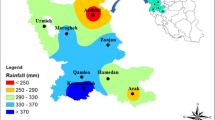Summary
Environmental correlation coefficients were computed among all pairs of five traits, namely grain yield, heading date, number of tillers per m2, plant height and 1000-grain weight (grain size) using 30 Triticum durum and 30 Triticum aestivum varieties grown in 18 environments. Grain yield was significantly correlated with the other four traits in almost all of the varieties. The mean correlation coefficient over all varieties ranged from 0.58 to −0.83 for durum wheat and 0.66 to 0.88 for aestivum wheat. The correlation coefficients between heading date and the other traits were also significant, ranging from −0.45 to −0.79 in durum wheat and −0.61 to −0.85 in aestivum wheat. The correlation coefficient between number of tillers with plant height and 1000-grain weight were the smallest, 0.19−0.32 in durum wheat and 0.39−0.60 in aestivum wheat. It was concluded that agronomic practices favouring early and good stand establishment in the dry regions will favour the yield components and important adaptive traits, which contribute towards larger yields. Significant differences were found among genotypes in the environmental correlation coefficients and the associated changes in one trait as a result of changes in other traits.
Similar content being viewed by others
References
Daniels, R.W., M.B. Alcock & D.H. Scarisbrick, 1982. A reapraisal of stem reserve contribution to grain yield in spring barley (Hordeum vulgare L.). J. agric. Sci., Cambr. 98: 347–355.
Darwinkel, A., B.A. Ten Hag & J. Kuizenga, 1977. Effect of sowing date and seed rate on crop development and grain production of winter wheat. Netherland J. of Agr. Sci. 25: 83–94.
Falconer, D.S., 1960. Introduction to quantitative genetics. The Ronald Press Company, N. York, 365 p.
Gallacher, J.N., P.V. Biscoe & R.K. Scott, 1975. Barley and its environment. B. Stability of grain weight. J. of Appl. Ecol. 12: 319–336.
Hadjichristodoulou, A., 1982. The effects of annual precipitation and its distribution on grain yield of dryland cereals. J. of Agr. Sci. Cambr. 99: 261–270.
Hadjichristodoulou, A., 1987. The effects of optimum heading date and its stability on yield and consistency of performance of barley and durum wheat in dry areas. J. of Agr. Sci. Cambr. 108: 599–608.
Photiades, J. & A. Hadjichristodoulou, 1984. Sowing date, sowing depth, seed rate and row spacing of wheat and barley under dryland conditions. Field Crops Research 9: 151–162.
Scott, R.K. & Ruth Dennis-Jones, 1976. The physiological background of barley. J. of the Nat. Inst. of Agric. Bot. 14: 182–187.
Storrier, R.R. 1975. Wheat nutrition. In: A. Lazenby & E.M. Matheson (Eds) Australian Field Crops, Vol. 1: Wheat and Other Temperature Cereals, 256–287. Angus and Robertson, London.
Author information
Authors and Affiliations
Rights and permissions
About this article
Cite this article
Hadjichristodoulou, A. Environmental correlations among grain yield and other important traits of wheat in drylands. Euphytica 44, 143–150 (1989). https://doi.org/10.1007/BF00022609
Received:
Issue Date:
DOI: https://doi.org/10.1007/BF00022609




